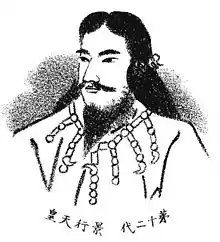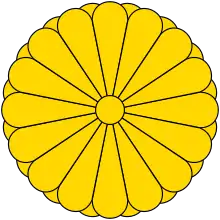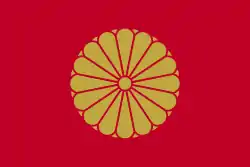Emperor Keikō
Emperor Keikō (景行天皇, Keikō-tennō), also known as Ootarashihikooshirowake no Sumeramikoto (大足彦忍代別天皇) was the 12th legendary Emperor of Japan, according to the traditional order of succession.[4][5] Both the Kojiki, and the Nihon Shoki (collectively known as the Kiki) record events that took place during Keikō's alleged lifetime. Keikō was recorded as being an exceptionally tall emperor who had a very large family. During his reign he sought to expand territorial control through conquest of local tribes. He had a very important son named "Prince Ōsu" (Yamato Takeru), who was in possession of the Kusanagi when he died. This treasure was later moved to Atsuta Shrine, and is now a part of the Imperial Regalia of Japan. There is a possibility that Keikō actually lived or reigned in the 4th century AD rather than the 1st, but more information is needed to confirm this view.
| Keikō | |||||
|---|---|---|---|---|---|
 | |||||
| Emperor of Japan | |||||
| Reign | 71–130 AD (traditional)[1] | ||||
| Predecessor | Suinin | ||||
| Successor | Seimu | ||||
| Born | Ōtarashihiko (大足彦尊) 13 BC[2] | ||||
| Died | 130 (aged 143) | ||||
| Burial | Yamanobe no michi no e no misasagi (山辺道上陵) (Nara) | ||||
| Spouse | |||||
| Issue | See below | ||||
| |||||
| House | Imperial House of Japan | ||||
| Father | Emperor Suinin | ||||
| Mother | Hibasu-hime[3] | ||||
| Religion | Shinto | ||||
Keikō's reign is conventionally considered to have been from 71 to 130 AD.[6] During his alleged lifetime, he fathered at least 80 children with two chief wives (empress) and nine consorts. One of his sons became the next emperor upon his death in 130 AD, but the location of Keikō's grave (if any) is unknown. Keikō is traditionally venerated at a memorial Shinto tomb (misasagi) at Nara.
Legendary narrative
The Japanese have traditionally accepted this sovereign's historical existence, and a mausoleum (misasagi) for Keiko is currently maintained. The following information available is taken from the pseudo-historical Kojiki and Nihon Shoki, which are collectively known as Kiki (記紀) or Japanese chronicles. These chronicles include legends and myths, as well as potential historical facts that have since been exaggerated and/or distorted over time. The records state that Keikō was born sometime in 13 BC, and was given the name "Otarashihiko-no-mikoto".[3][2] He was the 3rd son of Emperor Suinin, and his second empress wife "Hibasu-hime".[3][7] Otarashihiko-no-mikoto was allegedly chosen as crown prince over his elder brother based on a casual question on what they both had wished for. In the former's case he said "The Empire" while his elder brother said "Bow and arrows".[8] Otarashihiko-no-mikoto later ascended to the throne in 71 AD, coming a year after his father's death.
Accounts in the Kojiki and Nihon Shoki are split when it comes to initial territorial expansion during Emperor Keikō's reign. In the Kojiki, the Emperor is said to have sent his son "Prince Ōsu" (Yamato Takeru) to Kyūshū to conquer local tribes. Alternatively, the Nihon Shoki records that he went there himself and won battles against local tribes. Both sources agree that Keikō later sent Yamato Takeru to Izumo Province, and eastern provinces to conquer the area and spread his territory.[9] According to traditional sources, Yamato Takeru died in the 43rd year of Emperor Keiko's reign (景行天皇四十三年).[10] The possessions of the dead prince were gathered together along with the sword Kusanagi; and his widow venerated his memory in a shrine at her home. Sometime later, these relics and the sacred sword were moved to the current location of the Atsuta Shrine.[10]
Emperor Keikō was recorded as 10 feet 2 inches tall (310.9 cm), who had at least 80 children from multiple wives.[8] This claim would put him into the category of Gigantism if verified, although as with other aspects it was more than likely exaggerated. Other than Yamato Takeru, at least three of Keikō's children were ancestors of notable clans. Emperor Keikō died in 130 AD at the age of 143, and his son Prince Wakatarashihiko was enthroned as the next emperor the following year.[2]
Known information
Emperor Keikō is regarded by historians as a "legendary Emperor" as there is insufficient material available for further verification and study.[11] The name Keikō-tennō was assigned to him posthumously by later generations.[12] His name might have been regularized centuries after the lifetime ascribed to Keikō, possibly during the time in which legends about the origins of the Yamato dynasty were compiled as the chronicles known today as the Kojiki.[9] There is a possibility that Keikō's era was in the 4th century AD rather than the 1st.[13] This period is concurrent with the Kentoshi having an audience with the Tang Emperor, more evidence is needed though to make any conclusions. Like his father before him, Keikō is also known to have an exaggerated lifespan which is unlikely to be factual. The consecutive reigns of the emperors began to be compiled in the 8th century, and it is thought that age gaps were "filled up" as many lacunae were present.[14][15] For comparison, verified ages in the 110s have since been documented and recorded as the "oldest in the world".
While the actual site of Keikō's grave is not known, the Emperor is traditionally venerated at a memorial Shinto shrine (misasagi) at Nara. The Imperial Household Agency designates this location as Keikō's mausoleum, and is formally named Yamanobe no michi no e no misasagi.[4][10] Outside of the Kiki, the reign of Emperor Kinmei[lower-alpha 1] (c. 509 – 571 AD) is the first for which contemporary historiography has been able to assign verifiable dates.[16] The conventionally accepted names and dates of the early Emperors were not confirmed as "traditional" though, until the reign of Emperor Kanmu[lower-alpha 2] between 737 and 806 AD.[9]
Consorts and children
Emperor Keikō allegedly had a very large family which consisted of 2 wives, 9 concubines, and more than 80 children (51 of which are listed here). It is now questionable and open to debate though, if these numbers are genuine or not.[17] Some of his listed children might actually be duplicates of the same person. The size of Keikō's family also could have been exaggerated over time through legends and word of mouth stories.
Spouse
| Position | Name | Father | Issue |
|---|---|---|---|
| Empress (1st) | Princess Harima no Inabi no Ōiratsume (播磨稲日大郎姫) | Prince Wakatakehiko[lower-alpha 3] | • Prince Kushitsunowake (櫛角別王) • Prince Ōsu (大碓皇子) • Prince Ōsu (小碓尊) |
| Empress (2nd) | Yasakairi-hime (八坂入媛命) | Prince Yasakairihiko[lower-alpha 4] | • Prince Wakatarashihiko (稚足彦尊) • Prince Iokiirihiko (五百城入彦皇子) • Prince Oshinowake (忍之別皇子) • Prince Wakayamatoneko (稚倭根子皇子) • Prince Ōsuwake (大酢別皇子) • Princess Nunoshino-hime-miko (渟熨斗皇女) • Princess Iokiirihime-miko (五百城入姫皇女) • Princess Kagoyori-hime-miko (麛依姫皇女) • Prince Isakiirihiko (五十狭城入彦皇子) • Prince Kibinoehiko (吉備兄彦皇子) • Princess Takagiiri-hime-miko (高城入姫皇女) • Princess Oto-hime-miko (弟姫皇女) |
Concubines
| Name | Father | Issue |
|---|---|---|
| Mizuhanoiratsume (水歯郎媛) | Prince Iwatsukuwake[lower-alpha 5] | • Princess Ionono-hime-miko (五百野皇女) |
| Ikawa-hime (五十河媛) | Unknown | • Prince Kamukushi (神櫛皇子) • Prince Inaseirihiko (稲背入彦皇子) |
| Abenotakada-hime (阿倍高田媛) | Abe no Kogoto | • Prince Takekunikoriwake (武国凝別皇子) |
| Himuka no Kaminagaootane (日向髪長大田根) | Unknown | • Prince Himuka no Sotsuhiko (日向襲津彦皇子) |
| Sonotake-hime (襲武媛) | Unknown | • Prince Kunichiwake (国乳別皇子) • Prince Kunisewake (国背別皇子) • Prince Toyotowake (豊戸別皇子) |
| Himukanomihakashi-hime (日向御刀媛) | Unknown | • Prince Toyokuniwake (豊国別皇子) |
| Inabinowakairatsume (伊那毘若郎女) | Prince Wakatakehiko | • Prince Mawaka (真若王) • Prince Hikohitoōe (彦人大兄命) |
| Igoto-hime (五十琴姫命) | Mononobe no Igui | • Prince Igotohiko (五十功彦命) |
| Unknown | Unknown | • See below |
Issue
01.jpg.webp)
| Status | Name | Mother | Comments |
|---|---|---|---|
| Prince | Kushitsunowake (櫛角別王) | Harima no Inabi no Ōiratsume | |
| Prince | Ōsu (大碓皇子) | Harima no Inabi no Ōiratsume | Ancestor of Mugetsu no kimi (身毛津君) |
| Prince | Yamato Takeru (aka Ōsu) (小碓尊) | Harima no Inabi no Ōiratsume | Ōsu, later known as Yamato Takeru, was the father of Emperor Chūai. |
| Prince | Wakatarashihiko (稚足彦尊) | Yasakairi-hime | Wakatarashihiko became the next emperor. (Known as "Seimu" posthumously) |
| Prince | Iokiirihiko (五百城入彦皇子) | Yasakairi-hime | |
| Prince | Oshinowake (忍之別皇子) | Yasakairi-hime | |
| Prince | Wakayamatoneko (稚倭根子皇子) | Yasakairi-hime | |
| Prince | Ōsuwake (大酢別皇子) | Yasakairi-hime | |
| Princess | Nunoshino-hime-miko (渟熨斗皇女) | Yasakairi-hime | |
| Princess | Iokiirihime-miko (五百城入姫皇女) | Yasakairi-hime | |
| Princess | Kagoyori-hime-miko (麛依姫皇女) | Yasakairi-hime | |
| Prince | Isakiirihiko (五十狭城入彦皇子) | Yasakairi-hime | Isakiirihiko is the ancestor of Mitsukai no Muraji (御使連) |
| Prince | Kibinoehiko (吉備兄彦皇子) | Yasakairi-hime | |
| Princess | Takagiiri-hime-miko (高城入姫皇女) | Yasakairi-hime | |
| Princess | Oto-hime-miko (弟姫皇女) | Yasakairi-hime | |
| Princess | Ionono-hime-miko (五百野皇女) | Mizuhanoiratsume | Ionono-hime-miko was possibly also a Saiō. |
| Prince | Kamukushi (神櫛皇子) | Ikawa-hime | |
| Prince | Inaseirihiko (稲背入彦皇子) | Ikawa-hime | |
| Prince | Takekunikoriwake (武国凝別皇子) | Abenotakada-hime | |
| Prince | Himuka no Sotsuhiko (日向襲津彦皇子) | Himuka no Kaminagaootane | |
| Prince | Kunichiwake (国乳別皇子) | Sonotake-hime | |
| Prince | Kunisewake (国背別皇子) | Sonotake-hime | |
| Prince | Toyotowake (豊戸別皇子) | Sonotake-hime | |
| Prince | Toyokuniwake (豊国別皇子) | Himukanomihakashi-hime | Ancestor of Himuka no Kuni no miyatsuko (日向国造) |
| Prince | Mawaka (真若王) | Inabinowakairatsume | |
| Prince | Hikohitoōe (彦人大兄命) | Inabinowakairatsume | |
| Prince | Igotohiko (五十功彦命) | Igoto-hime | |
| Princess | Shirogane (銀王) | Unknown | Married Prince Hikohitoōe |
| Prince | Wakaki-no-Irihiko (若木之入日子王) | Unknown | Speculated as the same person with Prince Iokiirihiko |
| Prince | Wakayahiko (稚屋彦命) | Unknown | |
| Prince | Amatarashine (天帯根命) | Unknown | |
| Prince | Takekunikowake (武国皇別命) | Unknown | Speculated as the same person with Prince Takekunikoriwake |
| Prince | Ososhikowake (大曽色別命) | Unknown | |
| Prince | Iwakosowake (石社別命) | Unknown | |
| Prince | Takeoshiwake (武押別命) | Unknown | Speculated as the same person with Prince Oshinowake |
| Prince | Sonomewake (曽能目別命) | Unknown | |
| Prince | Tochiribiko (十市入彦命) | Unknown | |
| Prince | Sonowashiwake (襲小橋別命) | Unknown | |
| Prince | Shirokoriwake (色己焦別命) | Unknown | |
| Prince | Okinaga-no-hikohitoōe-Mizuki (息長彦人大兄水城命) | Unknown | Speculated as the same person with Prince Hikohitoōe |
| Prince | Kuma-no-Oshitsuhiko (熊忍津彦命) | Unknown | |
| Prince | Takeotowake (武弟別命) | Unknown | |
| Prince | Kusaki (草木命) | Unknown | |
| Prince | Tagotowake (手事別命) | Unknown | |
| Prince | Oaretowake (大我門別命) | Unknown | |
| Prince | Toyohiwake (豊日別命) | Unknown | |
| Prince | Mikawa-no-Sukune (三河宿禰命) | Unknown | |
| Prince | Toyotewaka (豊手別命) | Unknown | |
| Prince | Yamato-no-Sukune (倭宿禰命) | Unknown | |
| Prince | Toyotsuhiko (豊津彦命) | Unknown | |
| Prince | Okoriwake (大焦別命) | Unknown |
See also
- List of Emperors of Japan
- Imperial cult
- Takahashi Ujibumi
Notes
- The 29th Emperor[5][7]
- Kanmu was the 50th sovereign of the Yamato dynasty
- Wakatakehiko was one of Emperor Kōrei's sons.
- Yasakairihiko was one of Emperor Sujin's sons.
- Iwatsukuwake was one of Emperor Suinin's sons.

References
- "Genealogy of the Emperors of Japan" (PDF). Kunaicho.go.jp. Retrieved July 30, 2019.
- Kenneth Henshall (2013). Historical Dictionary of Japan to 1945. Scarecrow Press. p. 487. ISBN 9780810878723.
- Memoirs of the Research Department of the Toyo Bunko (the Oriental Library), Issues 32-34. Toyo Bunko. 1974. p. 63. Retrieved July 30, 2019.
- "景行天皇 (12)". Imperial Household Agency (Kunaichō) (in Japanese). Retrieved July 31, 2019.
- Titsingh, Isaac. (1834). Nihon Ōdai Ichiran (in French). Royal Asiatic Society, Oriental Translation Fund of Great Britain and Ireland. pp. 11, 34–36.
- Ponsonby-Fane, Richard. (1959). The Imperial House of Japan, p. 33.
- Brown, Delmer M. and Ichirō Ishida (1979). A Translation and Study of the Gukanshō, an Interpretative History of Japan Written in 1219. University of California Press. pp. 248, 261–262. ISBN 9780520034600.
- Brinkley, Frank, Dairoku, Kikuchi (1915). A History of the Japanese People: From the Earliest Times to the End of the Meiji Era. Encyclopaedia Britannica Company. p. 85. Retrieved July 30, 2019.
emperor keiko children.
CS1 maint: multiple names: authors list (link) - Aston, William George. (1896). Nihongi: Chronicles of Japan from the Earliest Times to A.D. 697, Volume 2. The Japan Society London. p. 109 & 188–214.
- Ponsonby-Fane, Richard (1953). Studies in Shinto and Shrines. Ponsonby-Fane Society Publications. pp. 419, 433–435.
- Kelly, Charles F. "Kofun Culture". www.t-net.ne.jp. Retrieved May 28, 2019.
- Brinkley, Frank (1915). A History of the Japanese People from the Earliest Times to the end of the Meiji Era. Encyclopaedia Britannica Company. p. 21.
Posthumous names for the earthly Mikados were invented in the reign of Emperor Kanmu (782–805), i.e., after the date of the compilation of the Records and the Chronicles.
- Japan Review: Bulletin of the International Research Center for Japanese Studies, Issue 1. International Research Center for Japanese Studies. 1990. p. 37. Retrieved July 30, 2019.
- Chisholm, Hugh (1911). The Encyclopædia Britannica: A Dictionary of Arts, Sciences, Literature and General Information, Volume 15. At the University Press. p. 253. Retrieved July 30, 2019.
Emperor Keiko longevity.
- The New Werner Twentieth Century Edition of the Encyclopaedia Britannica: Volume 13. Werner Company. 1906. p. 591. Retrieved July 30, 2019.
- Hoye, Timothy. (1999). Japanese Politics: Fixed and Floating Worlds. Prentice Hall. p. 78. ISBN 9780132712897.
According to legend, the first Japanese Emperor was Jimmu. Along with the next 13 Emperors, Jimmu is not considered an actual, historical figure. Historically verifiable Emperors of Japan date from the early sixth century with Kimmei.
- Hosokawa, Bill (1997). Old Man Thunder: Father of the Bullet Train. Sogo Way. p. 9. ISBN 9780965958004. Retrieved July 30, 2019.
Further reading
- Aston, William George. (1896). Nihongi: Chronicles of Japan from the Earliest Times to A.D. 697. London: Kegan Paul, Trench, Trubner. OCLC 448337491
- Brown, Delmer M. and Ichirō Ishida, eds. (1979). Gukanshō: The Future and the Past. Berkeley: University of California Press. ISBN 978-0-520-03460-0; OCLC 251325323
- Chamberlain, Basil Hall. (1920). The Kojiki. Read before the Asiatic Society of Japan on April 12, May 10, and June 21, 1882; reprinted, May, 1919. OCLC 1882339
- Ponsonby-Fane, Richard Arthur Brabazon. (1959). The Imperial House of Japan. Kyoto: Ponsonby Memorial Society. OCLC 194887
- __________. (1953). Studies in Shinto and Shrines. Kyoto: Ponsonby Memorial Society. OCLC 470294859
- Titsingh, Isaac. (1834). Nihon Ōdai Ichiran; ou, Annales des empereurs du Japon. Paris: Royal Asiatic Society, Oriental Translation Fund of Great Britain and Ireland. OCLC 5850691
- Varley, H. Paul. (1980). Jinnō Shōtōki: A Chronicle of Gods and Sovereigns. New York: Columbia University Press. ISBN 978-0-231-04940-5; OCLC 59145842
| Regnal titles | ||
|---|---|---|
| Preceded by Emperor Suinin |
Legendary Emperor of Japan 71–130 AD (traditional dates) |
Succeeded by Emperor Seimu |
